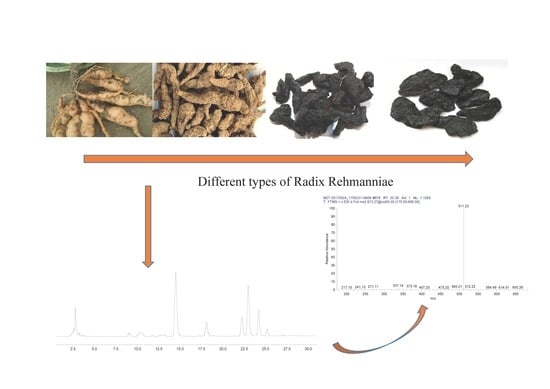Simultaneous Analysis of Saccharides between Fresh and Processed Radix Rehmanniae by HPLC and UHPLC-LTQ-Orbitrap-MS with Multivariate Statistical Analysis
Abstract
:1. Introduction
2. Results
2.1. Quantification of Saccharides in Four Kinds of RRs
2.2. Analysis of Saccharide Compounds in FRR and Third Different Processed Products, in PRR1 to PRR9, and in Dis1 to Dis9
2.3. Idetification of the Saccharides of Four Different Processed RRs
2.3.1. Oligosaccharides
2.3.2. Monosaccharides
2.4. Analysis of the Transformation Mechanism of Saccharides
3. Discussion
4. Materials and Methods
4.1. Plant Materials
4.2. Chemical and Reagents
4.3. Sample Preparation
4.3.1. Preparation of Saccharide Samples
4.3.2. PMP Derivatization of Saccharides
4.3.3. Acid Hydrolysis of Saccharides
4.4. HPLC-RID Conditions
4.5. HPLC-DAD Conditions
4.6. UHPLC-ESI-MS Analysis
4.6.1. Liquid Chromatography
4.6.2. Mass Spectrometry
4.7. Quantitative Method Validation
4.8. Statistical Analysis
5. Conclusions
Acknowledgments
Author Contributions
Conflicts of Interest
References
- Tao, J.Z.; Zhao, M.; Wang, D.G.; Yang, C.; Cheng, G.T.; Zhang, X.; Pu, X.L.; Jiang, S. UPLC-Q-TOF/MS-based screening and identification of two major bioactive components and their metabolites in normal and CKD rat plasma, urine and feces after oral administration of Rehmannia glutinosa Libosch extract. J. Chromatogr. B 2015, 1001, 98–106. [Google Scholar] [CrossRef] [PubMed]
- Tao, J.Z.; Zhao, M.; Wang, D.G.; Yang, C.; Du, L.Y.; Qiu, W.Q.; Jiang, S. Biotransformation and metabolic profile of catalpol with human intestinal microflora by ultra-performance liquid chromatography coupled with quadrupole time-of-flight mass spectrometry. J. Chromatogr. B 2016, 1009–1010, 163–169. [Google Scholar] [CrossRef] [PubMed]
- The State Pharmacopoeia Commission of PR China. Pharmacopoeia of Peoples Republic of China; China Medical Science Press: Beijing, China, 2015; Volume I, pp. 124–125. [Google Scholar]
- Zhang, L.P.; Li, J.; Zhang, Z.L.; Wang, L. A Study on the Historical Changes of Preparation Method of Radix Rehmanniae Praeparata. J. Henan Coll. Tradit. Chin. Med. 2005, 20, 69–71. [Google Scholar]
- Li, S.L.; Song, J.Z.; Qiao, C.F.; Zhou, Y.; Qian, K.; Lee, K.H.; Xu, H.X. A novel strategy to rapidly explore potential chemical markers for the discrimination between raw and processed Radix Rehmanniae by UHPLC–TOFMS with multivariate statistical analysis. J. Pharm. Biomed. Anal. 2010, 51, 812–823. [Google Scholar] [CrossRef] [PubMed]
- Sun, X.M.; Zhang, Z.W. The modern study on the processing of Radix Rehmanniae. J. Changchun Coll. Tradit. Chin. Med. 1994, 10, 48–49. [Google Scholar]
- Li, C.S.; Zhang, Y.Q. Introduction and Evaluation of the Four-major Huai-yao Resources in Jiaozuo. Chin. Tradit. Herb. Drugs 2011, 17, 196–197. [Google Scholar]
- Zhang, R.X.; Li, M.X.; Jia, Z.P. Rehmannia glutinosa: Review of botany chemistry and pharmacology. J. Ethnopharmacol. 2008, 117, 199–214. [Google Scholar] [CrossRef] [PubMed]
- Tomoda, M.; Kato, S.; Onuma, M. Water-soluble constituents of Rehmanniae radix I. Carbohydrates and acids of Rehmannia glutinosa f. hueichingensis. Chem. Pharm. Bull. 1971, 19, 1455–1460. [Google Scholar] [CrossRef]
- Oshio, H.; Inouye, H. Iridoid glycosides of Rehmannia glutinosa. Phytochemistry 1982, 21, 133–138. [Google Scholar] [CrossRef]
- Chen, D.L.; Li, N.; Liu, L.; Long, H.M.; Lin, H.; Chen, J.; Zhang, H.M.; Zeng, C.C.; Liu, S.H. Confocal mirco-Raman spectroscopic analysis of the antioxidant protection mechanism of the oligosaccharides extracted from Morinda officinalis on human sperm DNA. J. Ethnopharmacol. 2014, 153, 119–124. [Google Scholar] [CrossRef] [PubMed]
- Zhang, R.X.; Zhou, J.H.; Jia, Z.P.; Zheng, P.; Zhang, Y.X.; Gu, G.M. Hypoglycemic effect of Rehmannia glutinosa oligosaccharide in hyperglycemic and alloxan-induced diabetic rats and its mechanism. J. Ethnopharmacol. 2004, 90, 39–43. [Google Scholar] [CrossRef] [PubMed]
- Consonni, R.; Cagliani, L.R.; Cogliati, C. NMR characterization of saccharides in Italian honeys of different floral source. J. Agric. Food Chem. 2012, 60, 4526–4534. [Google Scholar] [CrossRef] [PubMed]
- Domingueza, M.A.; Jacksénb, J.; Emmerb, Å.; Centurión, M.E. Capillary electrophoresis method for the simultaneous determination of carbohydrates and proline in honey samples. Microchem. J. 2016, 129, 1–4. [Google Scholar] [CrossRef]
- Ronkart, S.N.; Blecker, C.S.; Fourmanoir, H.; Fougnies, C.; Deroanne, C.; Van Herck, J.C.; Paquot, M. Isolation and identification of inulooligosaccharides resulting from inulin hydrolysis. Anal. Chim. Acta 2007, 604, 81–87. [Google Scholar] [CrossRef] [PubMed]
- Fu, D.; O’Neill, R.A. Monosaccharide composition analysis of oligosaccharides and glycoproteins by high-performance liquid chromatography. Anal. Biochem. 1995, 227, 377–384. [Google Scholar] [CrossRef] [PubMed]
- Chávez-Servin, J.L.; Castellote, A.I.; López-Sabater, M.C. Analysis of mono- and disaccharides in milk-based formulae by high-performance liquid chromatography with refractive index detection. J. Chromatogr. A 2004, 1043, 211–215. [Google Scholar] [CrossRef] [PubMed]
- Bhandari, P.; Kumar, N.; Singh, B.; Kaul, V.K. Simultaneous determination of sugars and picrosides in Picrorhiza species using ultrasonic extraction and high-performance liquid chromatography with evaporative light scattering detection. J. Chromatogr. A 2008, 1194, 257–261. [Google Scholar] [CrossRef] [PubMed]
- Dai, J.; Wu, Y.; Chen, S.W.; Zhu, S.; Yin, H.P.; Wang, M.; Tang, J. Sugar compositional determination of polysaccharides from Dunaliella salina by modified RP-HPLC method of precolumn derivatization with 1-phenyl-3-methyl-5-pyrazolone. Carbohydr. Polym. 2010, 82, 629–635. [Google Scholar] [CrossRef]
- Shen, X.D.; Perreault, H. Characterization of carbohydrates using a combination of derivatization, high-performance liquid chromatography and mass spectrometry. J. Chromatogr. A 1998, 811, 47–59. [Google Scholar] [CrossRef]
- Zhou, L.; Xu, J.D.; Zhou, S.S.; Mao, Q.; Kong, M.; Shen, H.; Li, X.Y.; Duan, S.M.; Xu, J.; Li, S.L. Integrating targeted glycomics and untargeted metabolomics to investigate the processing chemistry of herbal medicines, a case study on Rehmanniae Radix. J. Chromatogr. A 2016, 1472, 74–87. [Google Scholar] [CrossRef] [PubMed]
- Hotelling, H. Analysis of a complex of statistical variables into principal components. Br. J. Educ. Psychol. 1933, 24, 417–520. [Google Scholar] [CrossRef]
- Wu, W.H.; Wen, X.S.; Zhao, Y. Optimization of Manninotriose Preparation from Stachoyse. J. Chin. Med. Mater. 2007, 30, 848–851. [Google Scholar]
- Chang, W.T.; Chio, Y.H.; Van der Heijden, R.; Lee, M.S.; Lin, M.K.; Kong, H.; Kim, H.K.; Verpoorte, R.; Hankemeier, T.; Van der Greef, J.; et al. Traditional Processing Strongly Affects Metabolite Composition by Hydrolysis in Rehmannia glutinosa Roots. Chem. Pharm. Bull. 2011, 59, 546–552. [Google Scholar] [CrossRef] [PubMed]
- Gogus, F.H.; Bozkurt, H.; Eren, S. Kinetics of Maillard Reactions between the Major Sugars and Amino Acids of Boiled Grape Juice. LWT-Food Sci. Technol. 1998, 31, 196–200. [Google Scholar] [CrossRef]
- Guo, Y.X. Study on the Relationship between Maillard Reaction and Mechanism for Processing Radix Rehmanniae. Master’s Thesis, Shandong University, Shandong, China, 2012. [Google Scholar]
- Echavarría, A.P.; Pagán, J.; Ibarz, A. Melanoidins Formed by Maillard Reaction in Food and Their Biological Activity. Food Eng. Rev. 2012, 4, 203–223. [Google Scholar] [CrossRef]
- Liu, S.C.; Yang, D.J.; Jin, S.Y.; Hsu, C.H.; Chen, S.L. Kinetics of color development, pH decreasing, and anti-oxidative activity reduction of Maillard reaction in galactose/glycine model systems. Food Chem. 2008, 108, 533–541. [Google Scholar] [CrossRef] [PubMed]
- Guo, Y.X.; Wen, X.S.; Yu, Z.; Wei, G.D.; Sun, P. Maillard reaction contributing to chemical changes during the processing of Shu Dihuang, the steamed root of Rehmannia glutinosa. Asian. J. Tradit. Med. 2012, 7, 50–58. [Google Scholar]
Sample Availability: Not available. |

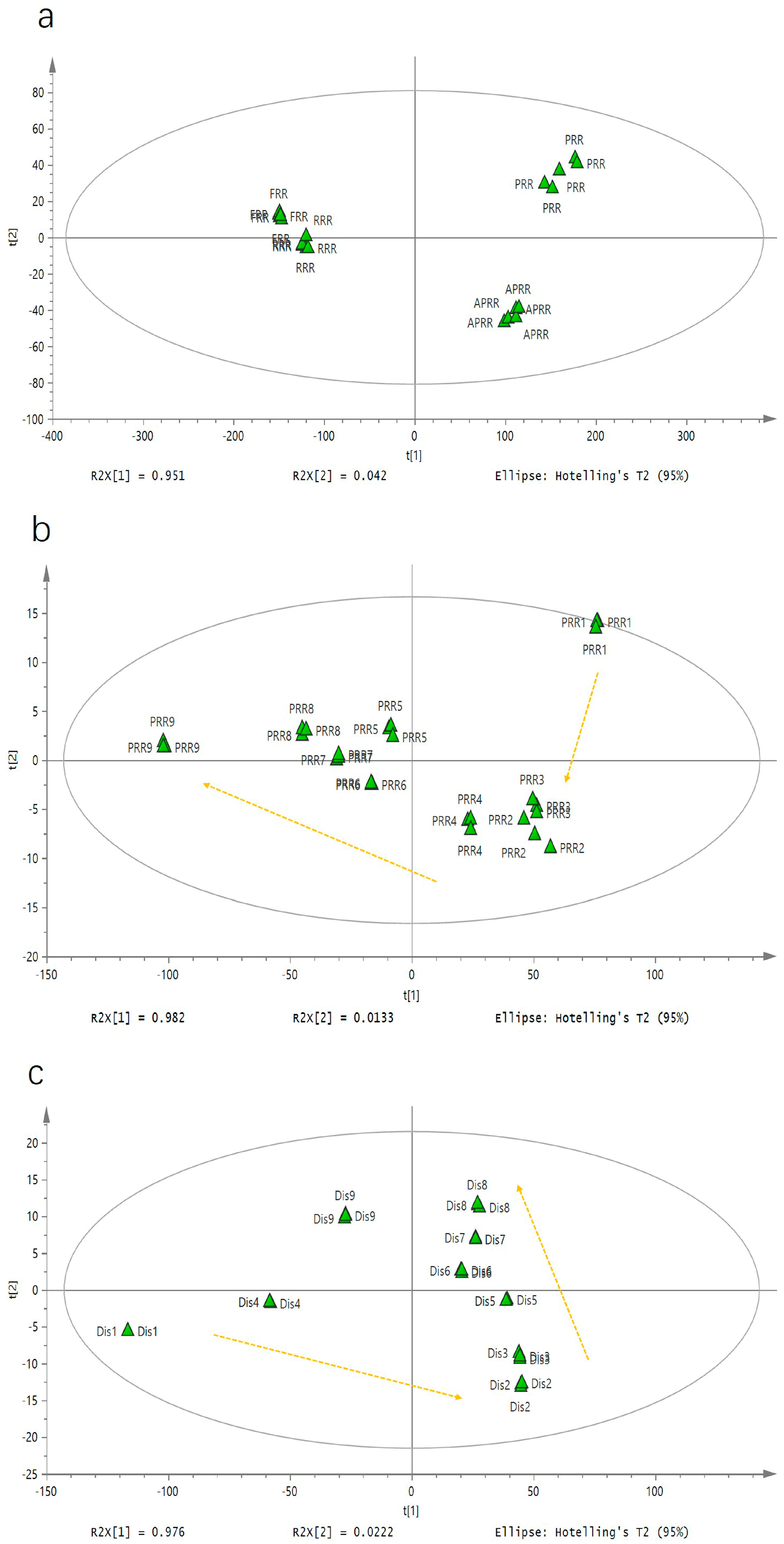
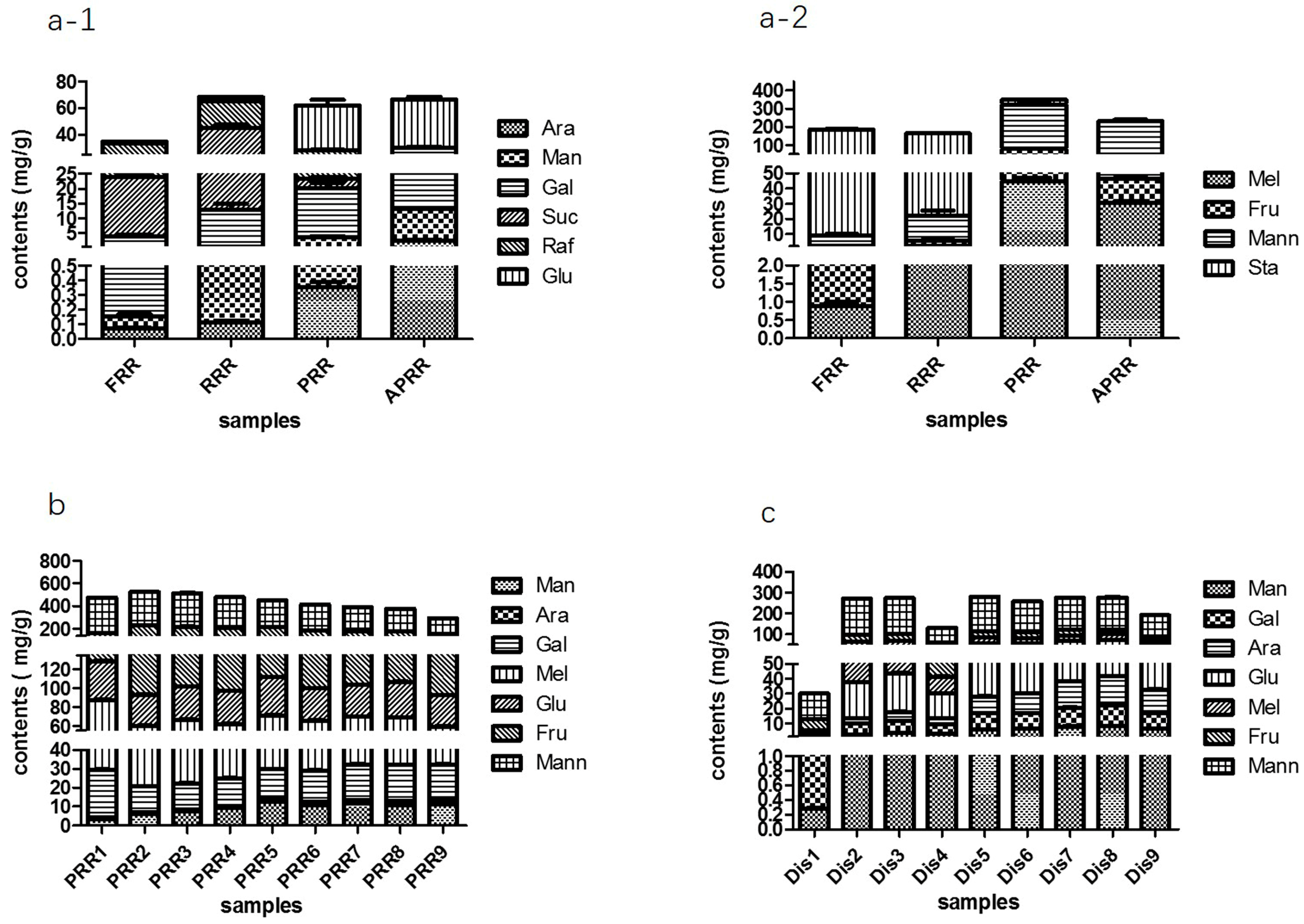
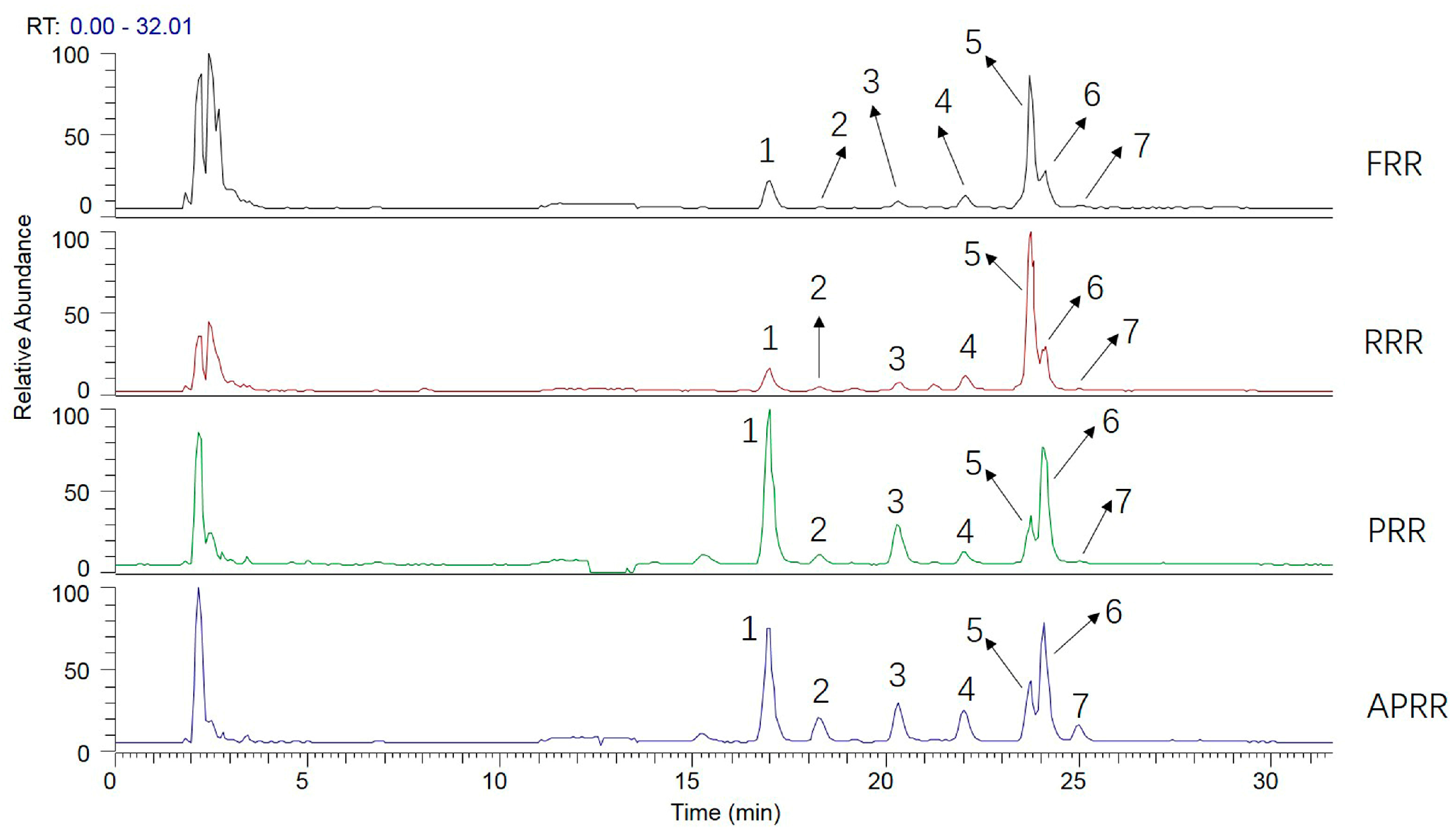
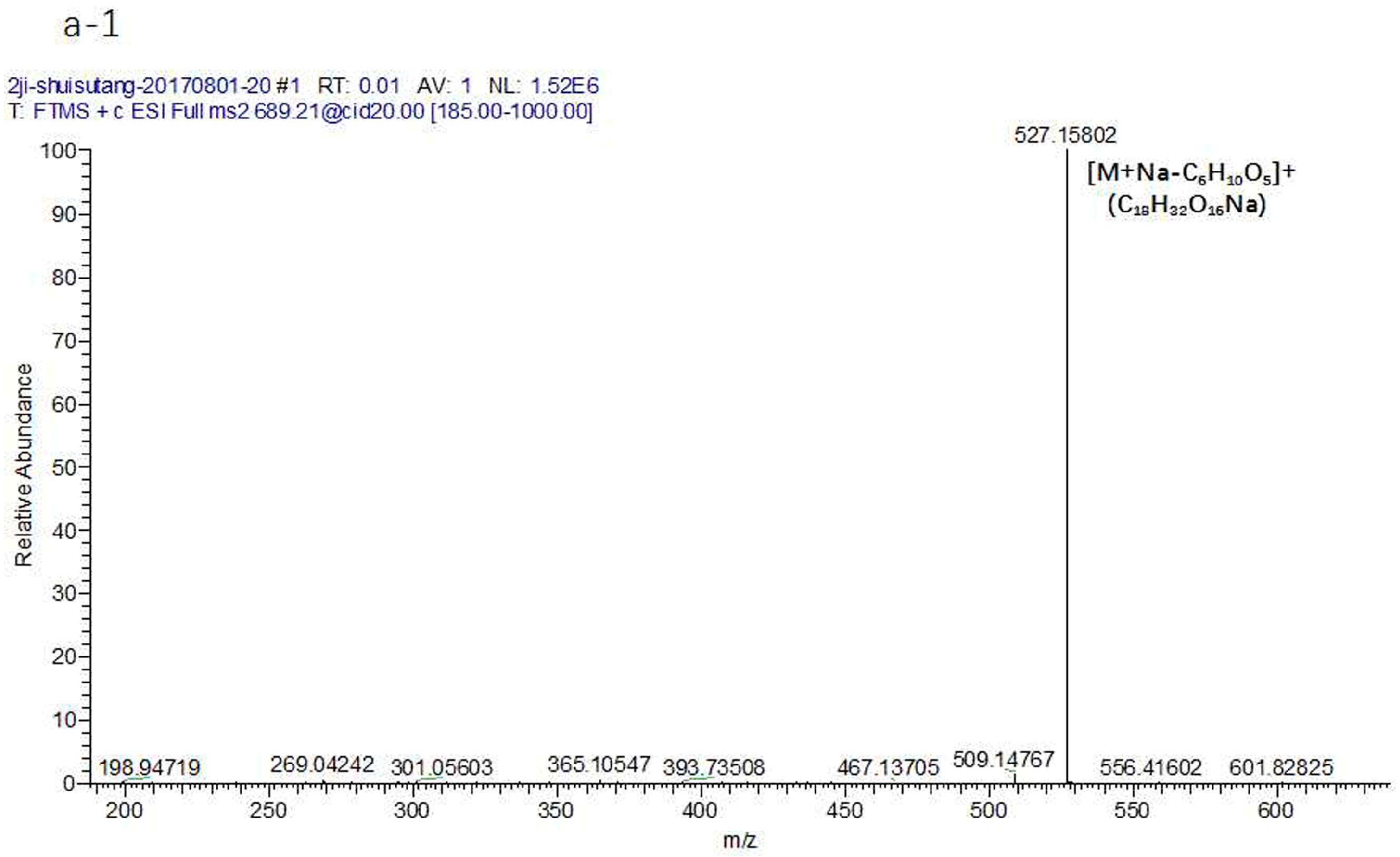
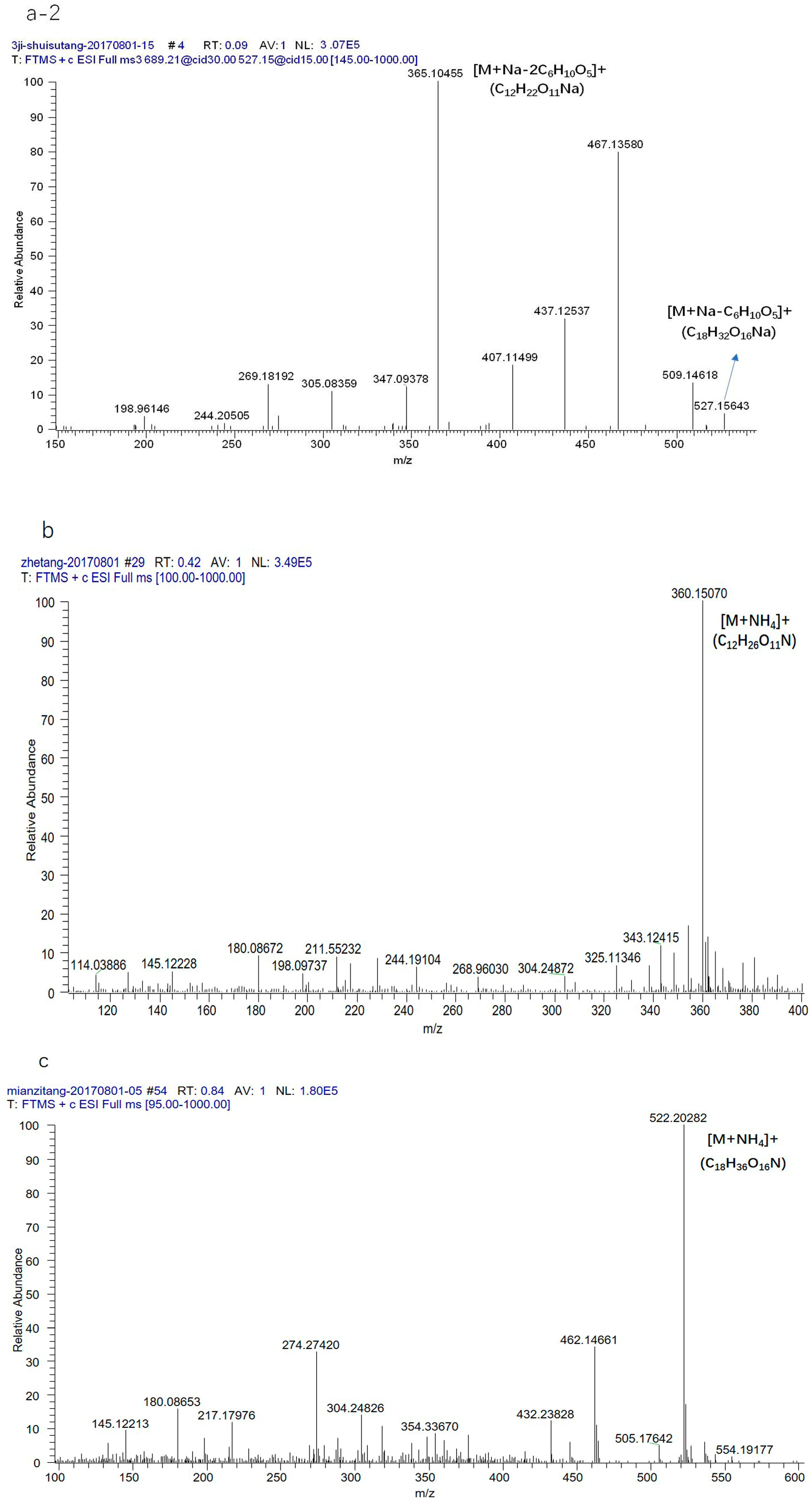
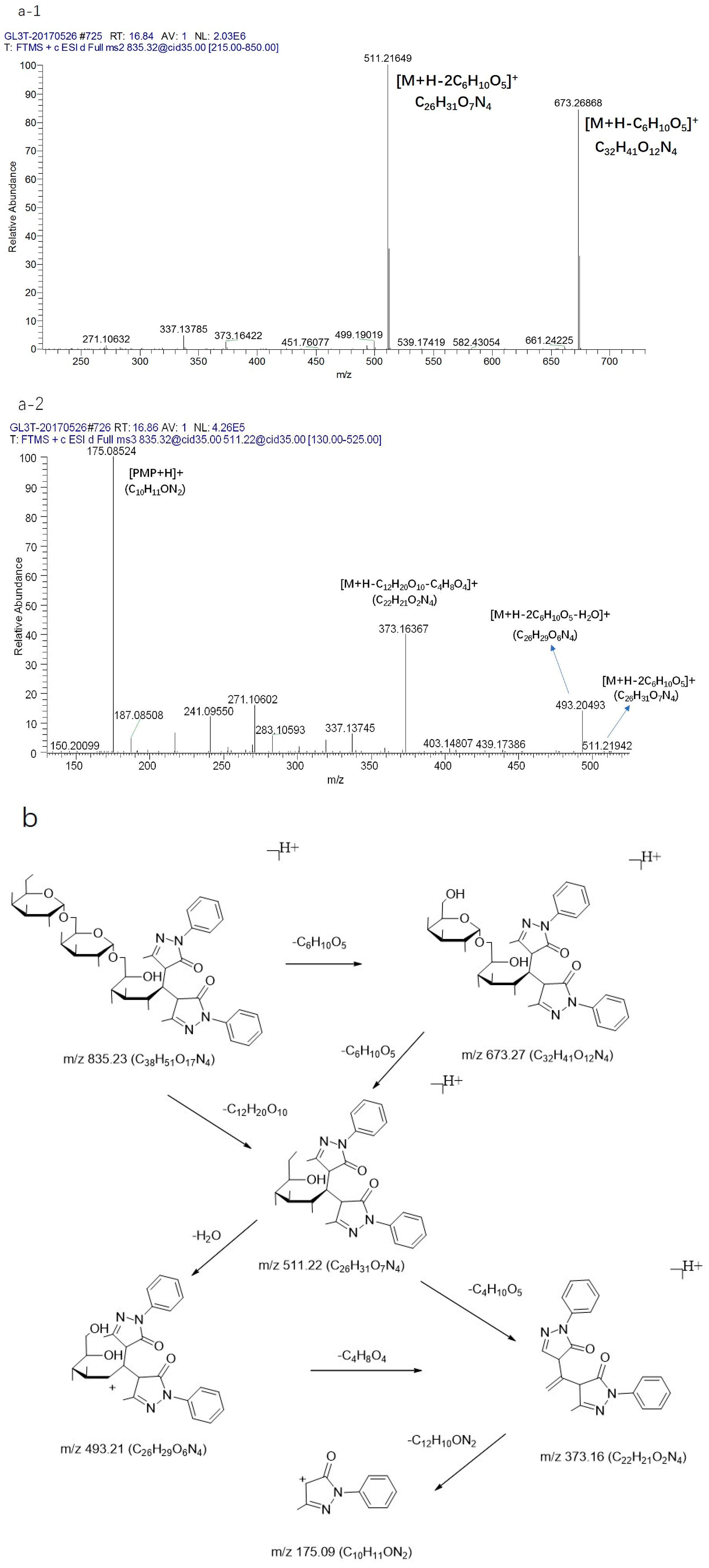
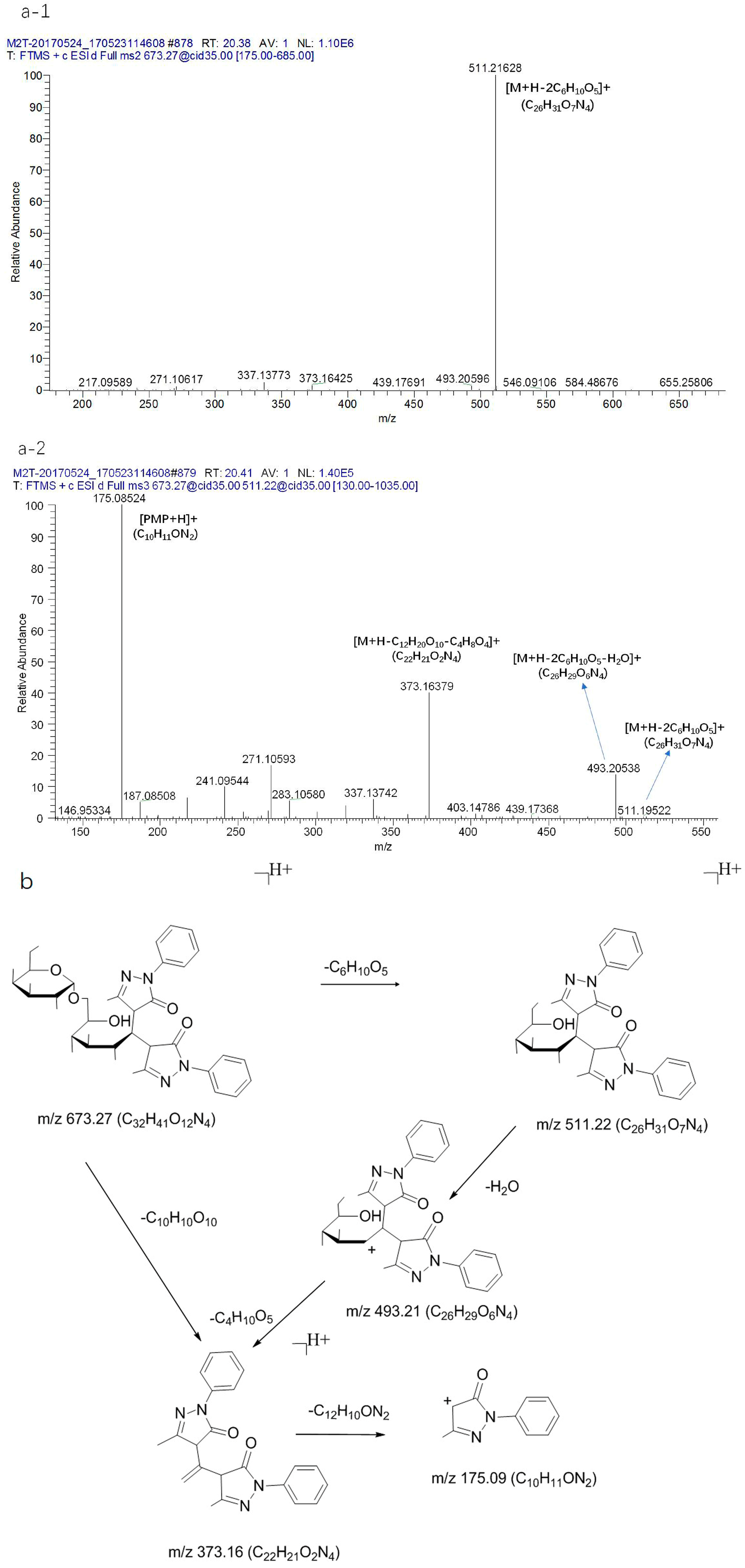
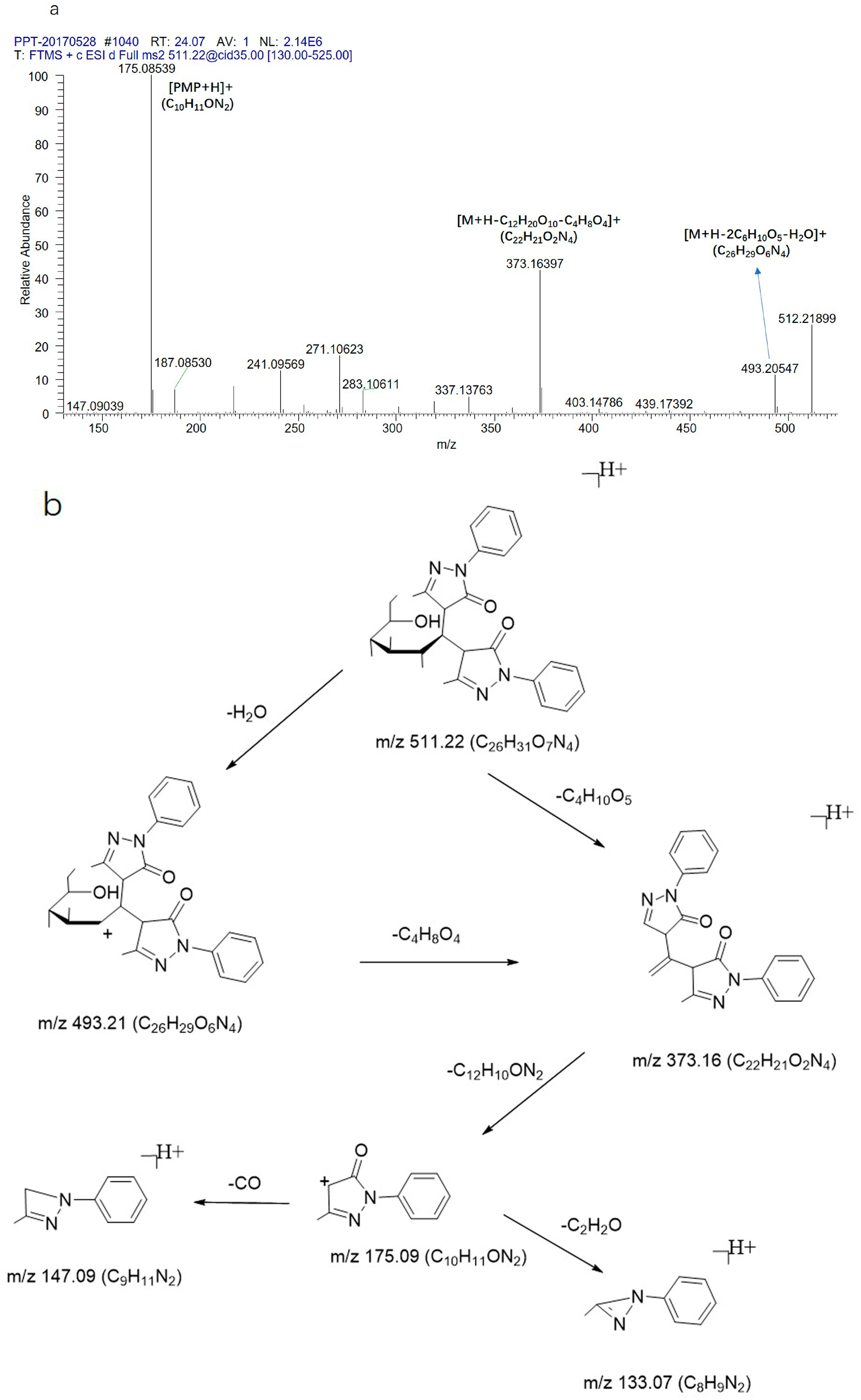
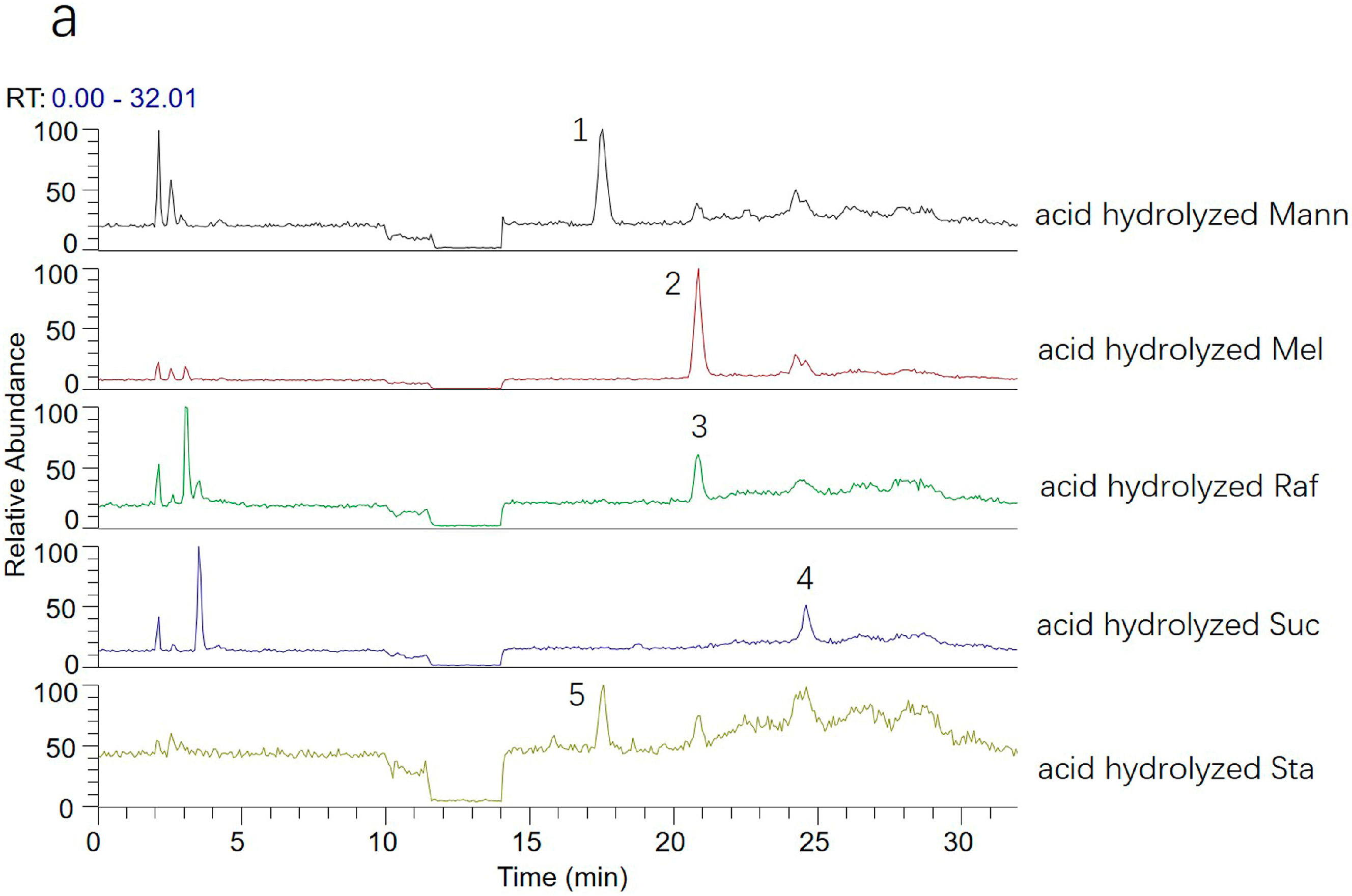

| Compound No. | tR (min) | Selection | Measured Mass | Molecular Formula | Error (ppm) | MSn m/z | Type |
|---|---|---|---|---|---|---|---|
| 1 * | 16.97 | [M + H]+ | 835.32263 | C38H51O17N4 | −2.086 | MS2 [835.32]: 673.27045, 511.21783; MS3 [673.27]: 493.20660, 373.16495 175.08597. | oligosaccharide |
| 2 * | 18.24 | [M + H]+ | 511.2178 | C26H31O7N4 | −1.811 | MS2 [511.22]: 493.20703, 373.16495, 175.08612; MS3 [175.09]: 147.09132, 133.07568. | monosaccharide |
| 3 * | 20.3 | [M + H]+ | 673.27039 | C32H41O12N4 | −1.721 | MS2 [673.27]: 511.21817; MS3 [511.22]: 493.20657, 373.16495, 175.08595. | oligosaccharide |
| 4 ** | 22.02 | [M + H]+ | 673.27032 | C32H41O12N4 | −1.825 | MS2 [673.27]: 511.21796; MS3 [511.22]: 493.20673, 373.16510, 175.086037. | oligosaccharide |
| 5 * | 23.74 | [M + H]+ | 511.21744 | C26H31O7N4 | −2.515 | MS2 [511.22]: 493.20685, 373.16510, 175.08604; MS3 [175.09]: 147.09114, 133.07556. | monosaccharide |
| 6 * | 24.1 | [M + H]+ | 511.21802 | C26H31O7N4 | −1.38 | MS2 [511.22]: 493.20712, 373.16534, 175.08617; MS3 [175.09]: 147.09120, 133.07559. | monosaccharide |
| 7 * | 25.01 | [M + H]+ | 481.20752 | C25H29O6N4 | −1.332 | MS2 [481.21]: 463.19638, 373.16513, 175.08611; MS3 [175.09]: 147.09125, 133.07565. | monosaccharide |
| Type | Standard | Selection | Precursor Ion | Molecular Formula | Error (ppm) | MSn | Fragment Ions | Elem. Comp. | Error (ppm) | Pathways |
|---|---|---|---|---|---|---|---|---|---|---|
| Trisaccharide | Manninotriose | [M + H]+ | 835.32098 | C38H51O17N4 | −4.061 | MS2 | 673.26868 | C32H41O12N4 | −4.261 | [M + H-C6H10O5]+ |
| 511.21649 | C26H31O7N4 | −4.373 | [M + H-2C6H10O5]+ | |||||||
| MS3 | 493.20493 | C26H29O6N4 | −6.551 | [M + H-2C6H10O5-H2O]+ | ||||||
| 373.16367 | C22H21O2N4 | −5.982 | [M + H-2C6H10O5-H2O-C4H8O4]+ | |||||||
| 175.08524 | C10H11ON2 | −7.708 | [M + H-2C6H10O5-H2O-C4H8O4-C12H10ON2]+ | |||||||
| Disaccharide | Melibiose | [M + H]+ | 673.26855 | C32H41O12N4 | −4.454 | MS2 | 511.21628 | C26H31O7N4 | −4.784 | [M + H-C6H10O5]+ |
| MS3 | 493.20538 | C26H29O6N4 | −5.639 | [M + H-C6H10O5-H2O]+ | ||||||
| 373.16379 | C22H21O2N4 | −5.661 | [M + H-C6H10O5-H2O-C4H8O4]+ | |||||||
| 175.08524 | C10H11ON2 | −7.708 | [M + H-C6H10O5-H2O-C4H8O4-C12H10ON2]+ | |||||||
| Monosaccharide | Glucose | [M + H]+ | 511.21628 | C26H31O7N4 | −4.608 | MS2 | 493.20547 | C26H29O6N4 | −5.456 | [M + H-H2O]+ |
| 373.16397 | C22H21O2N4 | −5.179 | [M + H-H2O-C4H8O4]+ | |||||||
| 175.08539 | C10H11ON2 | −6.851 | [M + H-H2O-C4H8O4-C12H10ON2]+ | |||||||
| MS3 | 147.09058 | C9H11N2 | −7.444 | [M + H-H2O-C4H8O4-C12H10ON2-CO]+ | ||||||
| 133.07504 | C8H9N2 | −7.401 | [M + H-H2O-C4H8O4-C12H10ON2-C2H2O]+ |
© 2018 by the authors. Licensee MDPI, Basel, Switzerland. This article is an open access article distributed under the terms and conditions of the Creative Commons Attribution (CC BY) license (http://creativecommons.org/licenses/by/4.0/).
Share and Cite
Xue, S.; Wang, L.; Chen, S.; Cheng, Y. Simultaneous Analysis of Saccharides between Fresh and Processed Radix Rehmanniae by HPLC and UHPLC-LTQ-Orbitrap-MS with Multivariate Statistical Analysis. Molecules 2018, 23, 541. https://doi.org/10.3390/molecules23030541
Xue S, Wang L, Chen S, Cheng Y. Simultaneous Analysis of Saccharides between Fresh and Processed Radix Rehmanniae by HPLC and UHPLC-LTQ-Orbitrap-MS with Multivariate Statistical Analysis. Molecules. 2018; 23(3):541. https://doi.org/10.3390/molecules23030541
Chicago/Turabian StyleXue, Shujuan, Lili Wang, Suiqing Chen, and Yongxian Cheng. 2018. "Simultaneous Analysis of Saccharides between Fresh and Processed Radix Rehmanniae by HPLC and UHPLC-LTQ-Orbitrap-MS with Multivariate Statistical Analysis" Molecules 23, no. 3: 541. https://doi.org/10.3390/molecules23030541



